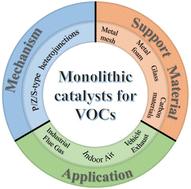单片异质结材料光催化去除挥发性有机化合物的研究进展
IF 4.2
3区 化学
Q2 CHEMISTRY, PHYSICAL
引用次数: 0
摘要
挥发性有机化合物(VOCs)因其环境毒性、致癌性和不断增加的排放而成为大气污染治理的重要目标。传统的粉状光催化剂面临传质受限、易失活和回收困难等挑战,而单片光催化材料通过载体设计有效地解决了这些缺点。本文系统综述了近年来整体材料在VOC降解领域的研究进展。首先,我们阐明了单片结构中p型、z型、s型异质结和Schottky结的反应机理和降解途径,阐明了各种异质结在光照下的电子转移模式,为设计高效催化剂提供理论基础。此外,我们系统地回顾了各种基材的改性方法、性能优化和实际应用,包括金属泡沫(镍/铜泡沫)、金属网、碳基材料(碳布、活性炭纤维和三聚氰胺泡沫)和玻璃基材。我们强调,底物结构和光催化活性位点的协同设计将是未来发展的关键。本综述为下一代高效VOC处理技术的开发提供了理论支持和设计指导。本文章由计算机程序翻译,如有差异,请以英文原文为准。

Photocatalytic removal of volatile organic compounds by monolithic heterojunction materials: a review
Volatile organic compounds (VOCs) have become critical targets for atmospheric pollution control due to their environmental toxicity, carcinogenicity, and continuously increasing emissions. Traditional powdered photocatalysts face challenges such as mass transfer limitations, easy deactivation, and difficulty in recycling, whereas monolithic photocatalytic materials effectively address these shortcomings through carrier design. In this paper, we systematically review the research progress on monolithic materials in the field of VOC degradation in recent years. Firstly, we elucidate the reaction mechanisms and degradation pathways of P-type, Z-type, S-type heterojunctions and Schottky junctions in monolithic structures, clarifying the electron transfer modes of various heterojunctions under illumination to provide theoretical foundations for the design of high-efficiency catalysts. Furthermore, we systematically review the modification methods, performance optimization, and practical applications of various substrates, including metal foams (nickel/copper foam), metal meshes, carbon-based materials (carbon cloth, activated carbon fiber, and melamine foam), and glass substrates. We highlight that the synergistic design of substrate structures and photocatalytic active sites will be crucial for future development. This review provides theoretical support and design guidelines for the development of next-generation high-efficiency VOC treatment technologies.
求助全文
通过发布文献求助,成功后即可免费获取论文全文。
去求助
来源期刊

Catalysis Science & Technology
CHEMISTRY, PHYSICAL-
CiteScore
8.70
自引率
6.00%
发文量
587
审稿时长
1.5 months
期刊介绍:
A multidisciplinary journal focusing on cutting edge research across all fundamental science and technological aspects of catalysis.
Editor-in-chief: Bert Weckhuysen
Impact factor: 5.0
Time to first decision (peer reviewed only): 31 days
 求助内容:
求助内容: 应助结果提醒方式:
应助结果提醒方式:


